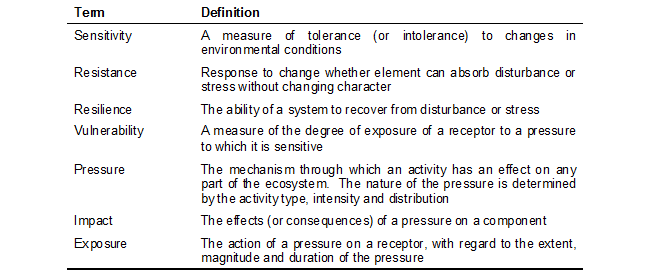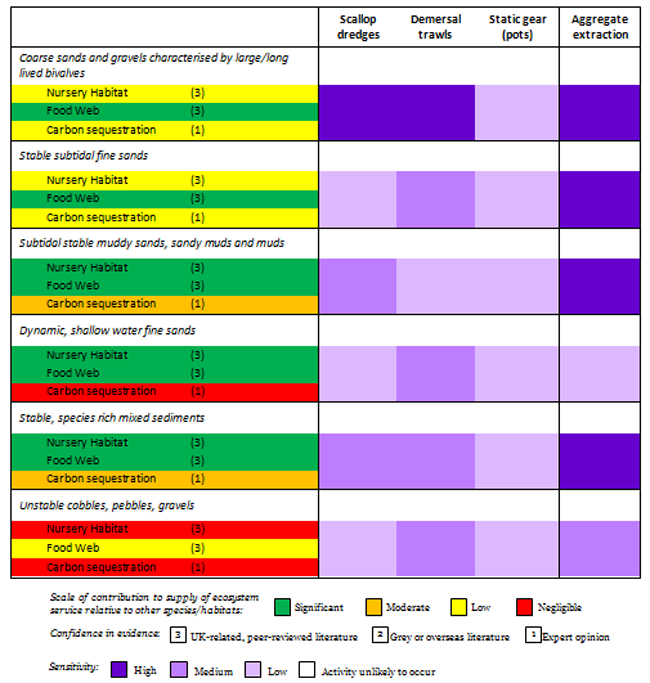3.3.3 Sensitivity assessment

Sensitivity assessments involve the collation of existing information on key characteristics of a species or habitat and its response to environmental change, and the presentation of this information in a format that is accessible to decision makers [Hiscock and Tyler-Waters, 2006]. Certain key concepts are fundamental to the sensitivity assessment approach, as defined by Tillin et al. [2010].
Table: Key definitions in sensitivity assessment (from Tillin et al., 2010)

If marine ecosystem services assessments are to become widely used in decision making, then the approach must provide information to help decision makers understand how changing levels of pressure affect the delivery of particular services and benefits.
Sensitivity assessments are widely used to evaluate the expected extent to which changes in certain pressures will affect particular species or habitats. Various methods for sensitivity assessments may be carried out: a synthesis of existing research, empirical approaches or a mix of both approaches.
One approach to assessing the sensitivity of marine ecosystem services to pressure changes is to build on existing work that has described both the ecosystem services, goods and benefits provided by marine and coastal habitats, and also on the sensitivity of these habitats to pressures. This is appropriate for a broad-based assessment that aims to provide an indication of the sensitivity of a suite of services to a range of pressures at generic levels of intensity.
The limitations of the synthesis approach may require a more empirical assessment in order to de-termine the sensitivity of particular marine ecosystem services in a specific situation. Two further empirical approaches to marine ecosystem services sensitivity assessment may be therefore suggested:
- a habitat-based approach, which follows a broadly similar method to the synthesis approach but is more specific to a local context and mix together expert and scientific knowledge;
- a benefit-based approach for situations in which there is no suitable existing information, such as when the direct linkages between certain habitats or species and a particular benefit are not clear. However, the benefit-based approach does not longer rely on ecological knowledge but on social demand.
The empirical approach for habitats and marine ecosystem services sensitivity assessment was applied in the North Devon Biosphere Reserve ![]() , Golfe Normand-Breton
, Golfe Normand-Breton ![]() and Poole Harbour
and Poole Harbour ![]() case study sites.
case study sites.
The following table provides an example of a matrix which presents for a series of habitats, the sensitivity of three regulation services to fishing gears and aggregate extraction in North Devon Biosphere Reserve. Of course, interpreting the results requires a precautionary principle as the scientific knowledge is not always suitable for the case and the expert judgments not comprehensive.
Table: The sensitivity of selected subtidal sedimentary habitats of the North Devon Biosphere Reserve to different fishing gears and to aggregate extraction

A similar approach was undertaken in the Golfe Normand-Breton study site [Cabral et al., 2014] ![]() .
.
In the Poole Harbour case study site, the focus was on cultural service (recreation) for which linkages between habitats/species and service provision were not clear. In this case, a benefit-based approach was chosen where sensitivity was assessed in terms of how user participation might be affected by changes to the environment within Poole Harbour. The approach required data generated by surveys (social science methods ![]() ).
).

